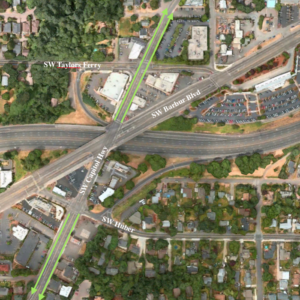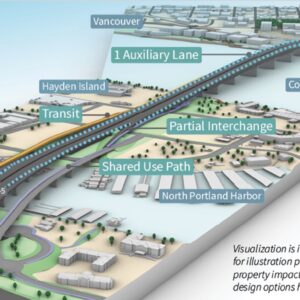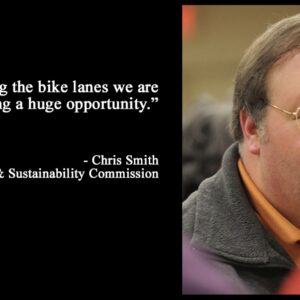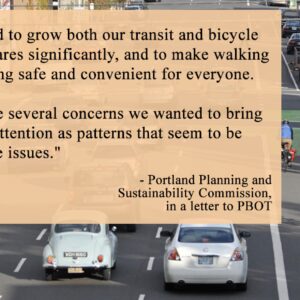
bold proposals, but his colleagues
weren’t quite ready to get behind them.
(Photo © J. Maus)
Yesterday, the Portland Planning Commission voted 5-0 to endorse the Portland Bicycle Plan for 2030. The unanimous vote is not surprising, but the important thing to note are their specific reommendations for the Plan that they’ll forward to City Council for official adoption in January.
In part due to testimony they heard at a public hearing for the plan back in October, the Commission put forth several recommendations along with their endorsement of the plan.
Planning Commissioner Chris Smith tried to push his colleagues into even more aggressive recommendations. He urged them to consider the Plan’s “25% of all trips by bike by 2030” as only an “interim target”. He wanted the Commission to “establish a goal to be in the top tier of world class cycling cities, with a bicycle mode share in excess of 40%.”
In addition, Smith wanted the Commission to adopt a significant increase in spending on cycling. In a memo he circulated to Commission members and spoke about at the hearing yesterday, Smith wrote that,
“City Council should immediately raise our level of investment comparable to the best practice in Europe, on the scale of $25-40 per capita per year [which would be $12 to 20 million per year], prioritizing investment in cycling above other modes as necessary to achieve this. Ultimately a level of funding slightly higher than this will be required to build out the projects envisioned by the Plan within a 20-year timeframe.”
Unfortunately, Smith’s proposal was a bit too bold for the Commission to sign on to. They did however sign on to several other specific recommendations (but none of them are as exciting as Smith’s!).
On strategy, the Commission responded to public testimony that questioned PBOT’s emphasis on bicycle boulevards in lieu of a similar focus on off-street trails and separated facilities (like cycle tracks) on main streets and in commercial areas.
The Commission said they agreed with PBOT that the “initial investments” should be made on bicycle boulevards in order to “bring a comfortable cycling experience to as wide a portion of Portland as possible.” But they added two specific recommendations to focus on trails and separated in-roadway bikeways like cycle tracks and buffered bike lanes:
- Fund project development of major off-street trail corridors in concert with Metro’s Intertwine effort so that these projects will be ready for implementation when construction funding becomes achievable in the future.
- Develop and implement a list of high priority pilot corridors for separated in-roadway bikeways that can be initially created with ‘software’ (paint, signal timing changes, plastic pylons) rather than ‘hardware’ (concrete, asphalt, new signals). Based on the results of these pilots, consider prioritizing permanent build-out of these corridors and construction of additional separated facilities.
Having the Commission prioritize a focus on separated bikeways like cycle tracks will make it easier (politically) for PBOT engineers and Mayor Adams to push forward on them (as I noted previously, they’re a bit tentative right now).
Another area the Commission addressed is the geographic equity of bikeway investments. They singled out “for early implementation” a study already identified in the Bicycle Plan that will look at “opportunities to increase access to bicycling in East Portland,” and a program to “develop culturally specific outreach and education.”
The Commission also recommended that bicycling take a page out of the streetcar and light rail playbook. Both of those modes have very effectively made the case that investment in rail lines will bring an increase in property values and development. Here’s how the Commission put it:
“Conduct research to comprehend the impact of cycling infrastructure and mode share on property values and make recommendations on the viability of value-capture funding methods (Local Improvement Districts, Tax-Increment Financing) along the lines of those used for Streetcar development.”
The idea is to create the same level of recognition around “bicycle-oriented development” among planners and policymakers that currently exists with “transit-oriented development.”
In other news, PBOT responded to Planning Commission with a host of changes they want to incorporate into the Final Draft of the Bicycle Plan. Among them was to eliminate the “tiers” label in their implementation strategy.
The tiers had become a source of confusion and concern from some. Trail advocates were disappointed that the two marquee projects — the North Portland Greenway and the Sullivan’s Gulch trails — were relegated to “Tier Two” status. The Bicycle Transportation Alliance (and others) thought that “Tier One” was merely a status quo funding scenario and that once completed, it would be hard to muster support and excitement for something called “Tier Two”.
What PBOT staff has decided to do is to combine Tiers One and Two into the “80 percent strategy” and Tier Three will now be known as the “world-class strategy”. In addition, they’ll update the implementation recommendations to include a four-year “immediate strategy” that includes “project development of the signature trails as well as implementation of funded and likely funded projects.”
You can review all the changes PBOT staff will make to the Final Draft of the Bicycle Plan here (PDF). More on the Planning Commission’s recommendations can be found on Chris Smith’s blog.
From here, the Portland Bicycle Plan will head to City Council for a hearing and possible adoption on January 20th.
(For more on Portland’s Bicycle Plan and the future of biking in our city, BikePortland will host a special evening with PBOT’s #1 bike guy Roger Geller on November 18th. Stay tuned to the Front Page for more details.)





Kudos to the Planning Commission for endorsing the plan but calling for earlier implementation of separated paths and cycletracks.
On the “bike blvd vs cycletrack” issue, I fail to understand how bike blvds are considered an inferior facility.
Vancouver BC has a highly developed bike blvd system and it’s the backbone of the bicycle commuter system. Their bike blvds are similar to Portland’s, except they have traffic signals at each crossing of an arterial. There’s also a bit more traffic calming, and somewhat more frequent use of car diverters.
If Portland upgraded its primary bike blvds with more signals, shorter wait time at signals, and car diverters every 10 or 20 blocks, I would think the bike blvd system would be far superior to a cycletrack system for commuters.
Ted Buehler
Excellent! Many thanks especially to Chris Smith for working on pushing the envelope further.
A quick note of thanks to each of the Planning Commission members for passing the plan would be a good idea. Carrot and stick!
Ted,
that’s exactly what PBOT seems to be doing right now with their new style of 15 miles of bike blvds that are coming soon (work on the Sellwood one has already started).
and I don’t think it’s a matter of choosing between which type of treatment is better than the other.
we need both a network of bike boulevards and a network of cycle tracks.
“I fail to understand how bike blvds are considered an inferior facility.”
Bike boulevards are often significantly offset from major commuting corridors or destinations. For example, I would much rather have a cycle-track on SE 9th than a meandering set of bike boulevards many blocks north or south. Cycle tracks are also needed in areas where bicycle boulevards are not feasible (e.g. downtown and in commercial areas). For example, the new cycle-track on broadway is great but there is no safe route going the other direction. I currently take 4th (?) but this is major bike-car mayhem.
To be honest, I only use bike boulevards when “leisure” riding with my significant other. Most are either too slow or out of the way for commuting or errands.
I think Chris Smith’s proposal was too bold, so I’m glad it wasn’t adopted. Portland is already so segregated, lacking in diversity, and unwelcoming to minorities, that prioritizing investment in the one transit mode (“above all others”) that is, by far, the most segregated would be a step in the wrong direction. It’s great that the Commission pulled out the development of “culturally specific outreach and education” for early implementation — that item seemed buried in the Plan as it was. I’m not so sure about the viability (or desirability) of the “value-capture funding methods” — sounds like more emphasis on high-end development and gentrification for the enrichment of property developers (and, of course, their cronies in city government & PDC) at the expense of low-income families who just get pushed further to the margins. This city already has enough of that.
Conduct research to comprehend the impact of cycling infrastructure and mode share on property values and make recommendations on the viability of value-capture funding methods (Local Improvement Districts, Tax-Increment Financing) along the lines of those used for Streetcar development.” the It makes me very uncomfortable that the one mode with by far
sorry, that second paragraph in the comment above isn’t suppose to be there.
I enjoy riding 4th and have experienced no mayem. unless there are going to be very substantial changes to the infrastructure — get rid of onstreet parking, at a minimum –, I don’t see cycletrack as a useful feature in the urban core. travel speeds are low enough that there is no real difficulty asserting a lane.
are, you’re right of course, assuming you want to maintain the status quo of people who bike. If the goal is to INCREASE mode share, then you have to accept the reality that some parts of downtown are scary for some people, and take steps to address that. I love the cycle track on Broadway, and would love to see a full set: one each north, south, east and west. Experienced cyclists would have full use of any street they like, and less confident folks would have a safer, more comfortable, if more limited option.
When 25% of trips within a 5 mile radius from home or work are made by bike, the savings PBOT will realize from less stress on the existing roadway, as well as the savings in time and money businesses receive from less motor traffic, will more than pay for the investment in getting folks out of cars at least part of the time. Not to mention the easier compliance with Clean Air standards. I look forward to the first protected ,offsteet facilities.
Kudos to the Planning Commission, and PBOT bike planners for the work they have done. When I saw the proposals presented to Planning Commission, I knew that this is not a case of PBOT not listening at first,but listening all through the process. Thank you Roger,Ellen and everyone who invested so much time and energy into this Master Plan. The challenge now is translating it into reality.
I was a little concerned when the draft plan was put out for comment, mostly in part to what I felt was a dismissal of off street trails, like npGreenway. My concerns are considerably lessened, and other components like the attention to equity issues make it a better Plan altogether.
“I enjoy riding 4th and have experienced no mayem.”
4th becomes a parking lot of angry car drivers during peak hours. And while I have a “friend” who weaves in and out of traffic like a lunatic, alot of riders taking the sidewalk.
A plan is nothing until it’s implemented and everything depends on HOW it’s implemented. It’s up to the bicycling community to ensure this plan is implemented to our benefit, rather than become a document of false hopes.
spare_wheel #4: “Bike boulevards are often significantly offset from major commuting corridors or destinations.” That may be, but one of the original bike boulevards (Clinton down to Ladd’s, over to the Hawthorne Bridge) is one of the main bike commuter arteries in the city.
I used to take advantage of the bike boulevard on Tillamook on my bike to work every day as well. The more bike boulevards that get built, the more they’ll be going to the destinations you want to get to.
“Bike boulevards are often significantly offset from major commuting corridors or destinations.”
I think the destinations part of that comment is key. If you can get across town, but can’t get to your grocery store on a comfortable facility, that’s a problem.
That’s one of the motivations for the cycle track (“separated in-roadway bikeways”) portion of the recommendation.